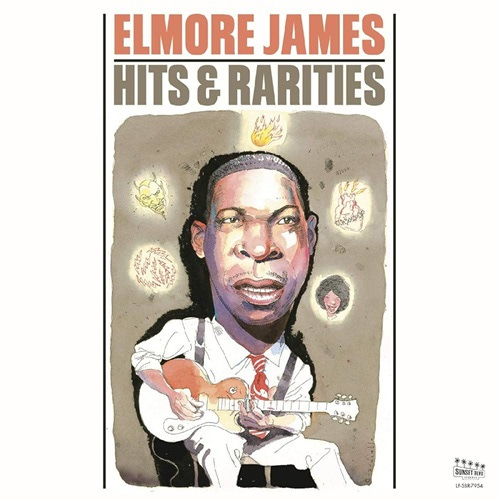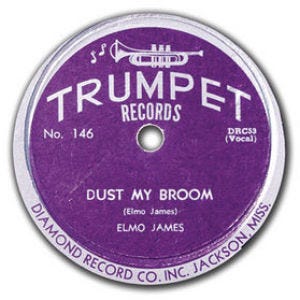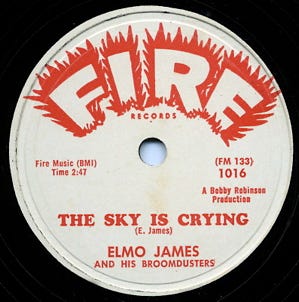Elmore James - Hits & Rarities
(Sunset Blvd Records, 2025)
For all the hand wringing and gnashing of teeth about the life of Robert Johnson, the bluesman with the most haphazard biography was Elmore James. Yet, no guitarist, not even Johnson, loomed so large over post-war blues as did James. And, all because of that one Johnson song:
That voice…like Skip James, full of dope and the Holy Spirit. A Mississippi Delta Isaiah, crying in the dark, rich dirt between Moon Lake and Lula.
That guitar, it was something else. Slide over and apply the algorithm to “The Sky Is Crying” (Fire Records, 1960)…
That sound must be the one Bob Dylan sought when recording Blonde on Blonde (Columbia, 1966):
“It's that thin, that wild mercury sound. It's metallic and bright gold with whatever that conjures up.”
James favored the price-friendly Kay Acoustic Guitars. Specifically, the Kay K-6000 "Western Rhythm" model. He often fitted it with two DeArmond pickups to electrify it. The combination of the Kay's construction and these specific pickups, as well as running it through an overdriven Gibson GA-40 Les Paul Combo contributed significantly to his unique tone.
That sound must be the one Bob Dylan sought when recording Blonde on Blonde:
“It's that thin, that wild mercury sound. It's metallic and bright gold with whatever that conjures up.1”
Coupled with that urgent, pleading voice, this guitar setup and the unlikely alignment of the stars leading to this hinge in blues history make up the package uniting the past with, not the present, but the future. James was the same phantom as was Robert Johnson, only he was hiding in plain sight.
The title Hits and Rarities is misleading. All the material released on this recording is readily available. There are no rarities (this is a series title used by the record label Sunset Blvd Records. Detailed records exist for all of James's recording sessions. They are just all over the place. That being said, James’s discography is only a slightly less of a mess than is John Lee Hooker’s, Hooker not being one to turn down any money and thus, recording often. The jazz trumpeter Chet Baker was the same way. There have been efforts to codify James’s output in collections like The Complete Fire and Enjoy Recordings (Collectables, 2006), Slide Order Of The Blues - The Singles As & Bs 1952-1962 (Jasmine Records, 2016), and The Classic Early Recordings: 51-56 (Ace Records, 2007).
What Hits and Rarities provides is a very good 36-song collection that is well suited for the new blues fan wanting a little more. The collection is granular enough to contain some of James’s lesser classics like “Strange Angel,” “Sunnyland,” and “Pickin’ the Blues.” Inclusion of additional James instrumentals, like “The Hawaiian Boogie” and “Elmore’s Contribution to Jazz” would have brightened the assembly. But no matter. This is a good starting place for when ‘lectricity came to the blues.
Rosenbaum, R. (1978). Playboy Interview: Bob Dylan, a Candid Conversation with the Visionary Whose Songs Changed the Times. Playboy, pp. 61-90.






